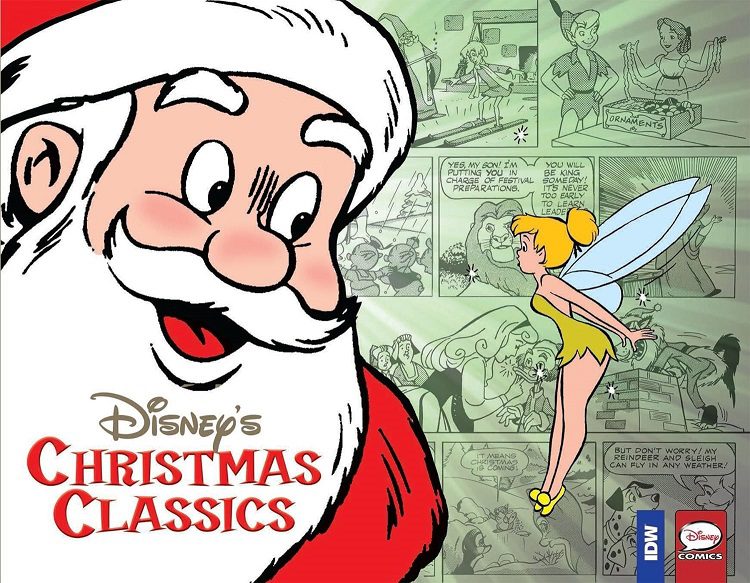
Considering how beloved Disney characters and Christmas are by children, it was surprising to learn in Alberto Becattini’s introductory essay “Merry Christmas, Disney Style” that they weren’t paired together in newspapers strips until “Peter Pan’s Christmas Story” debuted in November 28, 1960 after managing editor / administrator of Disney’s Comic Strip Department Frank Reilly pitched the idea to distributor Kings Features Syndicate. The annual “Disney Christmas Story” ran 27 times, concluding with “Snow White’s Sinister Christmas Gift” in 1987. Rebranded in 1992 as the “Disney Holiday Story,” these strips were tied into the films of the Disney Renaissance, ranging from Beauty and the Beast to The Hunchback of Notre Dame with the final story in 1997 skipping Hercules and bringing back The Little Mermaid gang.
“Peter Pan’s Christmas Story” finds Captain Hook looking to ruin Christmas, a common goal for the villains during the series. He sends Smee to blow up Santa Claus with a bomb hidden as a gift-wrapped present. The story creates a shared Disney universe by moving the Seven Dwarfs to the North Pole where they work for Santa. In a clever choice by writer Reilly, Smee disguises himself as a Dwarf, but the very next week, it’s completely undercut by terrible choices when none of the other Dwarfs notice an extra person at their dinner table.
The strips offer a mix of serious lessons, like Grumpy and a space alien learning about what the holiday means in “The Quest for Christmas;” fun romps, like “Captain Hook’s Christmas Caper” where Honest John and the Big Bad Wolf help him steal the toys from Santa’s workshop to ransom for barrels full of diamonds; and the inclusion of odd, non-Disney characters like the child ghosts in “A Castle for Christmas.”
The shared-universe stories will likely be Disney-fan favorites, as they were mine, because it is fun to see the characters commingle and interact. Set four years after the film, “Sleeping Beauty’s Christmas Story” sees Maleficent putting Aurora back to sleep. When her Fairy Godmothers are unable to wake her, they send out a call for help through space and time that is answered by Ludwig von Drake. During “Dumbo and the Christmas Mystery,” he and Timothy go in search of the lost Christmas Spirit and have to deal with Maleficent and Mad Madam Mim. Another wonderful creative decision was having Merlin turn into a crocodile during the aforementioned Hook’s caper. It was also pleasing to see Prince John, Mr. Toad, and the Beagle Boys make appearances.
During “Bambi’s Christmas Adventure,” he and his friends help return a lost letter to Santa, an idea repeated 17 years later by Carl Falberg took over writing duties in 1976 during “Cinderella’s Christmas Crisis. The only other writer was Floyd Norman, who wrote “Cruella’s Very Furry Christmas” (1986). He wrote the entire “Disney Holiday Story” series.
A variety of artists, listed in the book, contributed to the Christmas stories. The Disney characters look as they do in the films, but when drawing Santa, his appearance changes depending on the artist. The artwork for the Holiday stories were all done by Richard Moore, and he expertly captures the looks of the different films. In all the strips, all the art elements, such as the line work and shading, are impressive. The only blemish appears in “Snow White’s Sinister Christmas Gift” with the Wicked Witch. It looks like the black ink bled in several panels, leading to a loss of detail on her face and around her figure.
Disney’s Christmas Classics is another worthy addition to the Library of American Comics. Although the stories are clearly written for children, I imagine fans making an annual tradition of revisiting it after Thanksgiving or whenever they want a bit of Disney/Christmas magic in their lives.